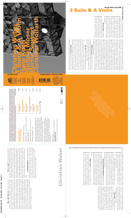|
Drummer Christian Wolfharthís approach is all texture, varying the degrees of temper detailing all the while, then threatening to erupt into biting percussive crescendos, but instead sustains a concen-trated pattern pool with undertow. His turbulent kit work turns rhythmic ideas at a starling pace, while pulling shards of harmonic scree from the cymbals edge with a bow atop, his performance becomes very interwoven with the strings of his collaborators. Weberís bass is the pillar of this controlled environment, to hold this together he introduces phased variations on a sustained draw, pauses, and chords which are placed sparingly to act as vertebrae to the piece, guiding its momentum and keeping the forms in place. At moments, his arco strokes sound as though the instrument is collapsing beneath the density of the chord. Themes are introduced and take form not as repetitions, but rather as viral, morphing themes that occur to be stated and restated in varying degrees of permutation. This music is charged with a tension that implies an underlying volatility to the players in that there are moments where the ensemble verges on exploding into insane free jazz. Were the music not burning with such a guided focus and tense |
determination to form, it could easily overheat into frantic free-form exchanges. In these moments, one is reminded that this is less hushed reductionism or oblique process music, as it results in elements of a more taut, economic, interpretation of cosmic jazz. More often than not we hear music that is imbued in crackle, not as seamless, clear diffusions of pure sound, but as a ruptured transmis-sion pitted with interferences. Whether itís the wax cylinder/78rpm transfers that carry Robert Johnstonís voice to us, the interference from a computer and radio static, amplifier hum etc. Music as we perceive it is more synchronized with the grit and fissures of its carriage than we care to notice. Most often we will accept noise as a quite acceptable blanket-backdrop. We become attached to the embedded noise, and it becomes a signifier of history,or charming reflection of the medium. As these instrumentalists are attached to the idiosyncrasies and faults of their instrument. The surface noises are articulated and dealt with in a concrete manner, where the noise is discretely consolidated into the language of ensemble. This is a music that reveals a great deal of its mechanics, and through exposing these |
material produced an incredibly dynamic and explicit rawness to the music. Which brings to mind that in much contemporary visual art and film, the aesthetics of process have become poetics in a world where transparencies and fractures are prevalent signifiers, it would seem responsible to address these matters of fact in word filled with glossiness and high demands for perfection. As it often brings rogue elements into focus in micro-sonic details, the work 3 Suits And A Violin brings into question the myths and truths of fidelity in the acoustic/instrumental attributes. In Christian Weber’s work noise has become closely connected to the repertoire, that his music sits very comfortably within this, as if to question if, then, noise has such a natural and reflexive occurrence on the instrumental practice, so then, he constructs pieces which are bathed in these static residues and phantom details. Dean M. Roberts, April 2006 |
|||||||||||||
